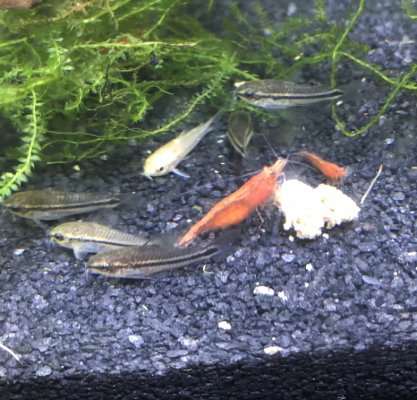libertybelle
Aquarium Advice Addict
Figured I would make a new thread as we have drifted far from the original topic of my other thread.
I have been losing shrimp at a rate of one or two a week consistently for weeks. Sometimes I’ll go a week with no loses and think everything is good again then the next week back to losing a couple more. And of course there is always the chance I’m losing more and not seeing them before their buddies ‘clean up.’ The population isn’t visibly crashing though so the rate of loss does appear to be slow and steady. I check parameters each time I lose a shrimp. Ammonia nitrite are always zero and nitrate stays below 5. I run tanks a little cool around 72 which I figure will slow down the growth of ... whatever is in there.
I think it started from an illness that ghost shrimp brought in (they became cloudy and lost ability to use their limbs) but they’ve all been removed and I still am having a slow steady shrimp loss over time.
I’ve seen no obvious signs of external parasites. The shrimp that I lose normally look fine until they’re dead. Sometimes I’ll catch one looking a little cloudy and know it will be the next to go. Today I found one deceased which looked the most abnormal I’ve seen. It was a cherry with dark patches on the torso which to me seems like it’s GOT to be some kind of internal infection.
But I’m still at a loss for how to treat. I have pratzi that I used for deworming my other tank and have both paraguard and Melafix on hand. I’ve seen reports that all of these are relatively shrimp safe but I’m not sure that any is actually the appropriate treatment.
Any advice? What the heck do you treat shrimp with when they have some unknown infection but you don’t have any idea what it is!
I have been losing shrimp at a rate of one or two a week consistently for weeks. Sometimes I’ll go a week with no loses and think everything is good again then the next week back to losing a couple more. And of course there is always the chance I’m losing more and not seeing them before their buddies ‘clean up.’ The population isn’t visibly crashing though so the rate of loss does appear to be slow and steady. I check parameters each time I lose a shrimp. Ammonia nitrite are always zero and nitrate stays below 5. I run tanks a little cool around 72 which I figure will slow down the growth of ... whatever is in there.
I think it started from an illness that ghost shrimp brought in (they became cloudy and lost ability to use their limbs) but they’ve all been removed and I still am having a slow steady shrimp loss over time.
I’ve seen no obvious signs of external parasites. The shrimp that I lose normally look fine until they’re dead. Sometimes I’ll catch one looking a little cloudy and know it will be the next to go. Today I found one deceased which looked the most abnormal I’ve seen. It was a cherry with dark patches on the torso which to me seems like it’s GOT to be some kind of internal infection.
But I’m still at a loss for how to treat. I have pratzi that I used for deworming my other tank and have both paraguard and Melafix on hand. I’ve seen reports that all of these are relatively shrimp safe but I’m not sure that any is actually the appropriate treatment.
Any advice? What the heck do you treat shrimp with when they have some unknown infection but you don’t have any idea what it is!

